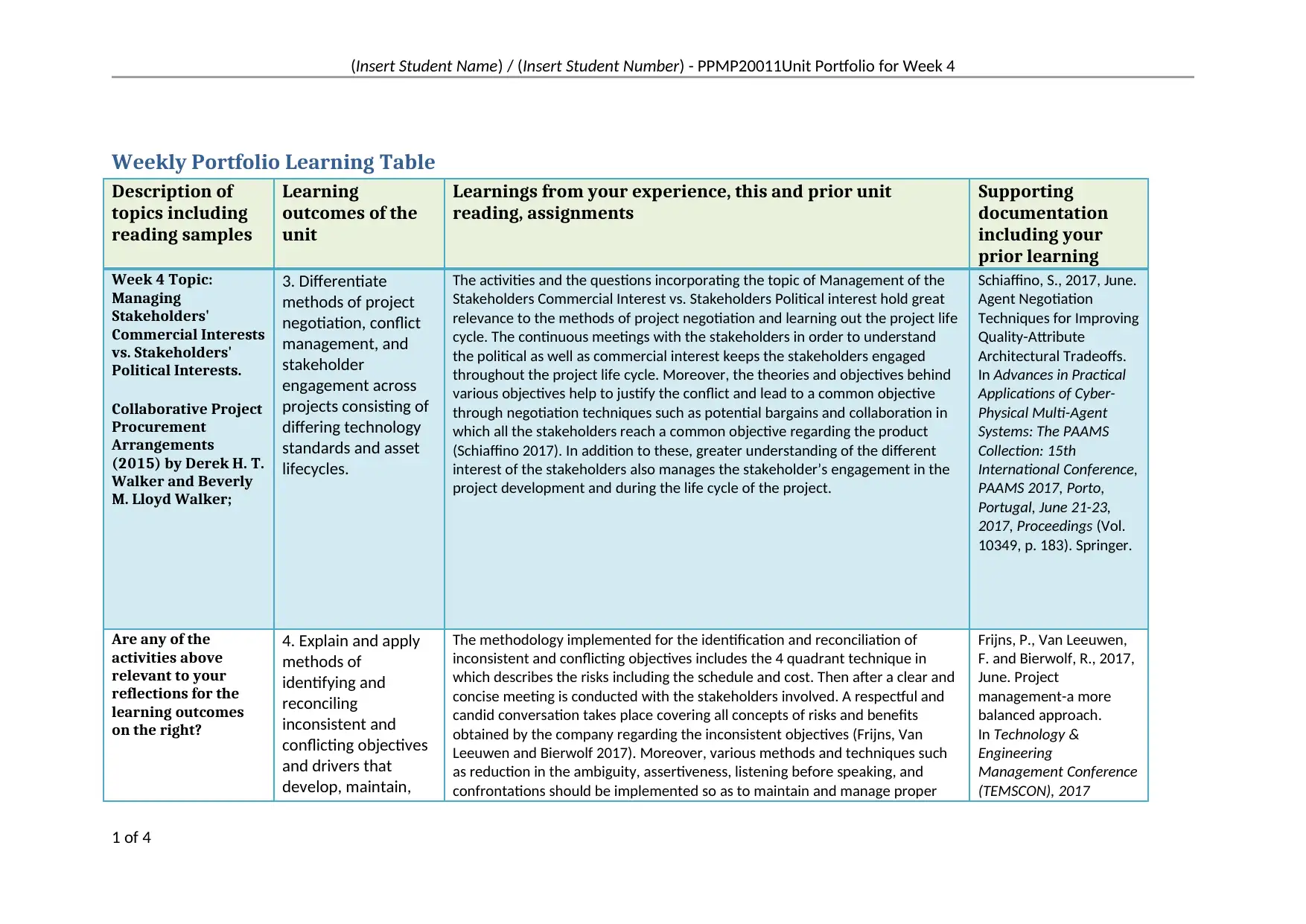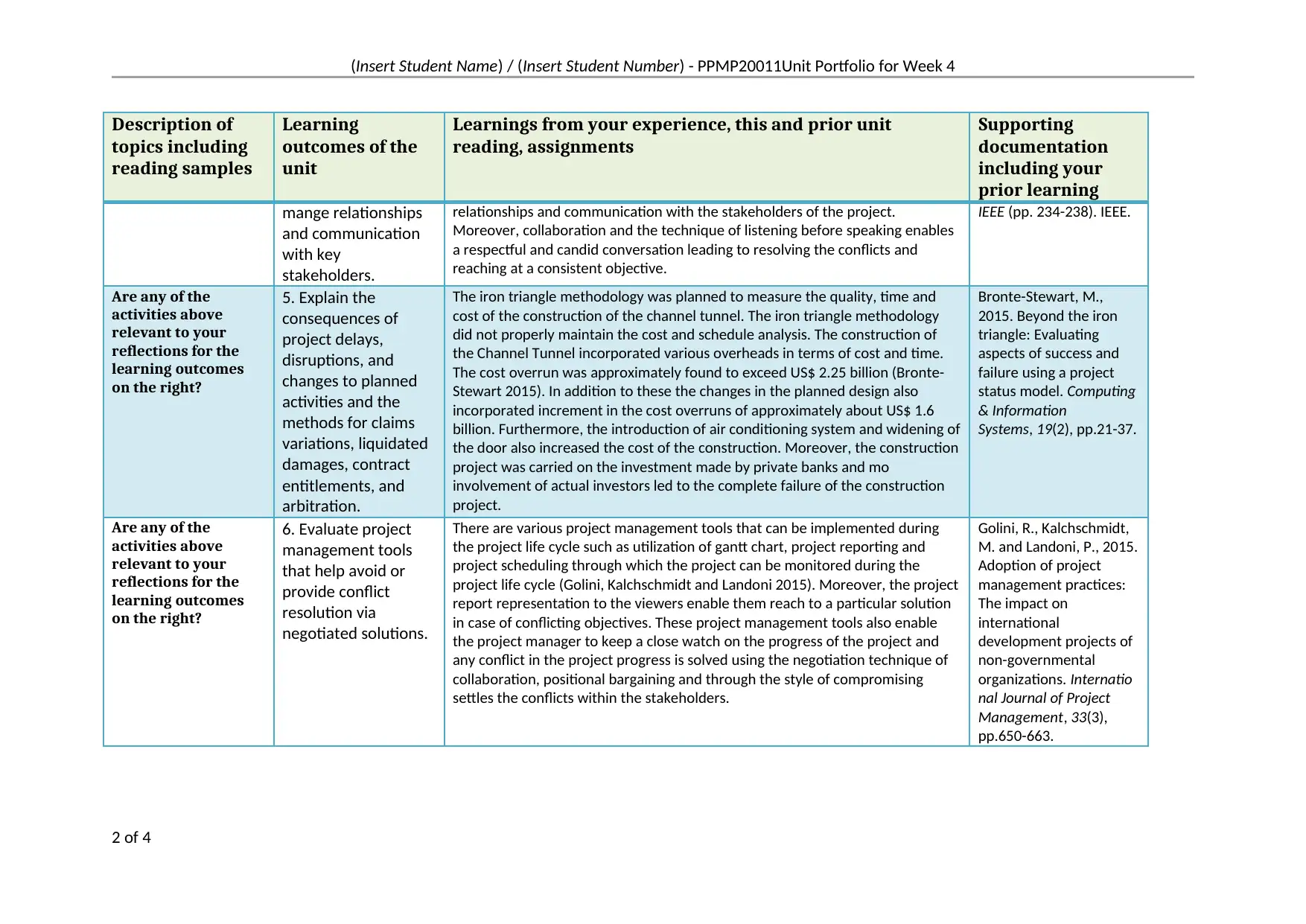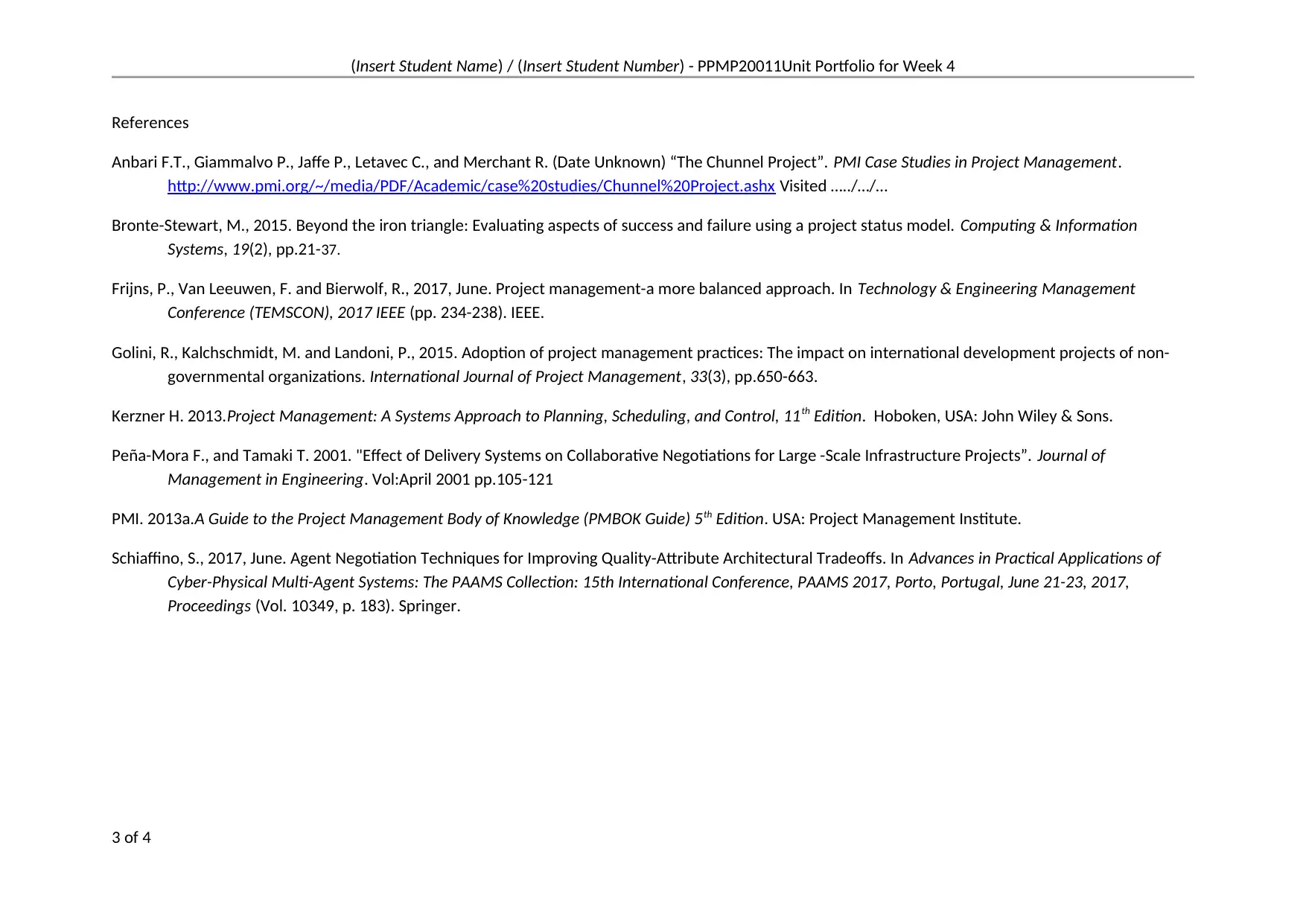PPMP20011 Unit Portfolio - Week 4: Stakeholder Interest Management
VerifiedAdded on 2021/04/21
|4
|1284
|426
Homework Assignment
AI Summary
This portfolio, created for the PPMP20011 unit, focuses on managing stakeholder interests in project management. It explores the complexities of balancing commercial and political interests, emphasizing negotiation, conflict management, and stakeholder engagement throughout the project lifecycle. The assignment examines methods for identifying and reconciling conflicting objectives, including the 4-quadrant technique and various communication strategies. It also analyzes the consequences of project delays and disruptions, providing insights into claims variations and contract entitlements using the Channel Tunnel project as a case study. Furthermore, the portfolio evaluates project management tools like Gantt charts and project reporting for conflict resolution. The student references several academic sources to support their analysis, offering a comprehensive overview of stakeholder management principles and practical applications within project environments.

(Insert Student Name) / (Insert Student Number) - PPMP20011Unit Portfolio for Week 4
Weekly Portfolio Learning Table
Description of
topics including
reading samples
Learning
outcomes of the
unit
Learnings from your experience, this and prior unit
reading, assignments
Supporting
documentation
including your
prior learning
Week 4 Topic:
Managing
Stakeholders'
Commercial Interests
vs. Stakeholders'
Political Interests.
Collaborative Project
Procurement
Arrangements
(2015) by Derek H. T.
Walker and Beverly
M. Lloyd Walker;
3. Differentiate
methods of project
negotiation, conflict
management, and
stakeholder
engagement across
projects consisting of
differing technology
standards and asset
lifecycles.
The activities and the questions incorporating the topic of Management of the
Stakeholders Commercial Interest vs. Stakeholders Political interest hold great
relevance to the methods of project negotiation and learning out the project life
cycle. The continuous meetings with the stakeholders in order to understand
the political as well as commercial interest keeps the stakeholders engaged
throughout the project life cycle. Moreover, the theories and objectives behind
various objectives help to justify the conflict and lead to a common objective
through negotiation techniques such as potential bargains and collaboration in
which all the stakeholders reach a common objective regarding the product
(Schiaffino 2017). In addition to these, greater understanding of the different
interest of the stakeholders also manages the stakeholder’s engagement in the
project development and during the life cycle of the project.
Schiaffino, S., 2017, June.
Agent Negotiation
Techniques for Improving
Quality-Attribute
Architectural Tradeoffs.
In Advances in Practical
Applications of Cyber-
Physical Multi-Agent
Systems: The PAAMS
Collection: 15th
International Conference,
PAAMS 2017, Porto,
Portugal, June 21-23,
2017, Proceedings (Vol.
10349, p. 183). Springer.
Are any of the
activities above
relevant to your
reflections for the
learning outcomes
on the right?
4. Explain and apply
methods of
identifying and
reconciling
inconsistent and
conflicting objectives
and drivers that
develop, maintain,
The methodology implemented for the identification and reconciliation of
inconsistent and conflicting objectives includes the 4 quadrant technique in
which describes the risks including the schedule and cost. Then after a clear and
concise meeting is conducted with the stakeholders involved. A respectful and
candid conversation takes place covering all concepts of risks and benefits
obtained by the company regarding the inconsistent objectives (Frijns, Van
Leeuwen and Bierwolf 2017). Moreover, various methods and techniques such
as reduction in the ambiguity, assertiveness, listening before speaking, and
confrontations should be implemented so as to maintain and manage proper
Frijns, P., Van Leeuwen,
F. and Bierwolf, R., 2017,
June. Project
management-a more
balanced approach.
In Technology &
Engineering
Management Conference
(TEMSCON), 2017
1 of 4
Weekly Portfolio Learning Table
Description of
topics including
reading samples
Learning
outcomes of the
unit
Learnings from your experience, this and prior unit
reading, assignments
Supporting
documentation
including your
prior learning
Week 4 Topic:
Managing
Stakeholders'
Commercial Interests
vs. Stakeholders'
Political Interests.
Collaborative Project
Procurement
Arrangements
(2015) by Derek H. T.
Walker and Beverly
M. Lloyd Walker;
3. Differentiate
methods of project
negotiation, conflict
management, and
stakeholder
engagement across
projects consisting of
differing technology
standards and asset
lifecycles.
The activities and the questions incorporating the topic of Management of the
Stakeholders Commercial Interest vs. Stakeholders Political interest hold great
relevance to the methods of project negotiation and learning out the project life
cycle. The continuous meetings with the stakeholders in order to understand
the political as well as commercial interest keeps the stakeholders engaged
throughout the project life cycle. Moreover, the theories and objectives behind
various objectives help to justify the conflict and lead to a common objective
through negotiation techniques such as potential bargains and collaboration in
which all the stakeholders reach a common objective regarding the product
(Schiaffino 2017). In addition to these, greater understanding of the different
interest of the stakeholders also manages the stakeholder’s engagement in the
project development and during the life cycle of the project.
Schiaffino, S., 2017, June.
Agent Negotiation
Techniques for Improving
Quality-Attribute
Architectural Tradeoffs.
In Advances in Practical
Applications of Cyber-
Physical Multi-Agent
Systems: The PAAMS
Collection: 15th
International Conference,
PAAMS 2017, Porto,
Portugal, June 21-23,
2017, Proceedings (Vol.
10349, p. 183). Springer.
Are any of the
activities above
relevant to your
reflections for the
learning outcomes
on the right?
4. Explain and apply
methods of
identifying and
reconciling
inconsistent and
conflicting objectives
and drivers that
develop, maintain,
The methodology implemented for the identification and reconciliation of
inconsistent and conflicting objectives includes the 4 quadrant technique in
which describes the risks including the schedule and cost. Then after a clear and
concise meeting is conducted with the stakeholders involved. A respectful and
candid conversation takes place covering all concepts of risks and benefits
obtained by the company regarding the inconsistent objectives (Frijns, Van
Leeuwen and Bierwolf 2017). Moreover, various methods and techniques such
as reduction in the ambiguity, assertiveness, listening before speaking, and
confrontations should be implemented so as to maintain and manage proper
Frijns, P., Van Leeuwen,
F. and Bierwolf, R., 2017,
June. Project
management-a more
balanced approach.
In Technology &
Engineering
Management Conference
(TEMSCON), 2017
1 of 4
Paraphrase This Document
Need a fresh take? Get an instant paraphrase of this document with our AI Paraphraser

(Insert Student Name) / (Insert Student Number) - PPMP20011Unit Portfolio for Week 4
Description of
topics including
reading samples
Learning
outcomes of the
unit
Learnings from your experience, this and prior unit
reading, assignments
Supporting
documentation
including your
prior learning
mange relationships
and communication
with key
stakeholders.
relationships and communication with the stakeholders of the project.
Moreover, collaboration and the technique of listening before speaking enables
a respectful and candid conversation leading to resolving the conflicts and
reaching at a consistent objective.
IEEE (pp. 234-238). IEEE.
Are any of the
activities above
relevant to your
reflections for the
learning outcomes
on the right?
5. Explain the
consequences of
project delays,
disruptions, and
changes to planned
activities and the
methods for claims
variations, liquidated
damages, contract
entitlements, and
arbitration.
The iron triangle methodology was planned to measure the quality, time and
cost of the construction of the channel tunnel. The iron triangle methodology
did not properly maintain the cost and schedule analysis. The construction of
the Channel Tunnel incorporated various overheads in terms of cost and time.
The cost overrun was approximately found to exceed US$ 2.25 billion (Bronte-
Stewart 2015). In addition to these the changes in the planned design also
incorporated increment in the cost overruns of approximately about US$ 1.6
billion. Furthermore, the introduction of air conditioning system and widening of
the door also increased the cost of the construction. Moreover, the construction
project was carried on the investment made by private banks and mo
involvement of actual investors led to the complete failure of the construction
project.
Bronte-Stewart, M.,
2015. Beyond the iron
triangle: Evaluating
aspects of success and
failure using a project
status model. Computing
& Information
Systems, 19(2), pp.21-37.
Are any of the
activities above
relevant to your
reflections for the
learning outcomes
on the right?
6. Evaluate project
management tools
that help avoid or
provide conflict
resolution via
negotiated solutions.
There are various project management tools that can be implemented during
the project life cycle such as utilization of gantt chart, project reporting and
project scheduling through which the project can be monitored during the
project life cycle (Golini, Kalchschmidt and Landoni 2015). Moreover, the project
report representation to the viewers enable them reach to a particular solution
in case of conflicting objectives. These project management tools also enable
the project manager to keep a close watch on the progress of the project and
any conflict in the project progress is solved using the negotiation technique of
collaboration, positional bargaining and through the style of compromising
settles the conflicts within the stakeholders.
Golini, R., Kalchschmidt,
M. and Landoni, P., 2015.
Adoption of project
management practices:
The impact on
international
development projects of
non-governmental
organizations. Internatio
nal Journal of Project
Management, 33(3),
pp.650-663.
2 of 4
Description of
topics including
reading samples
Learning
outcomes of the
unit
Learnings from your experience, this and prior unit
reading, assignments
Supporting
documentation
including your
prior learning
mange relationships
and communication
with key
stakeholders.
relationships and communication with the stakeholders of the project.
Moreover, collaboration and the technique of listening before speaking enables
a respectful and candid conversation leading to resolving the conflicts and
reaching at a consistent objective.
IEEE (pp. 234-238). IEEE.
Are any of the
activities above
relevant to your
reflections for the
learning outcomes
on the right?
5. Explain the
consequences of
project delays,
disruptions, and
changes to planned
activities and the
methods for claims
variations, liquidated
damages, contract
entitlements, and
arbitration.
The iron triangle methodology was planned to measure the quality, time and
cost of the construction of the channel tunnel. The iron triangle methodology
did not properly maintain the cost and schedule analysis. The construction of
the Channel Tunnel incorporated various overheads in terms of cost and time.
The cost overrun was approximately found to exceed US$ 2.25 billion (Bronte-
Stewart 2015). In addition to these the changes in the planned design also
incorporated increment in the cost overruns of approximately about US$ 1.6
billion. Furthermore, the introduction of air conditioning system and widening of
the door also increased the cost of the construction. Moreover, the construction
project was carried on the investment made by private banks and mo
involvement of actual investors led to the complete failure of the construction
project.
Bronte-Stewart, M.,
2015. Beyond the iron
triangle: Evaluating
aspects of success and
failure using a project
status model. Computing
& Information
Systems, 19(2), pp.21-37.
Are any of the
activities above
relevant to your
reflections for the
learning outcomes
on the right?
6. Evaluate project
management tools
that help avoid or
provide conflict
resolution via
negotiated solutions.
There are various project management tools that can be implemented during
the project life cycle such as utilization of gantt chart, project reporting and
project scheduling through which the project can be monitored during the
project life cycle (Golini, Kalchschmidt and Landoni 2015). Moreover, the project
report representation to the viewers enable them reach to a particular solution
in case of conflicting objectives. These project management tools also enable
the project manager to keep a close watch on the progress of the project and
any conflict in the project progress is solved using the negotiation technique of
collaboration, positional bargaining and through the style of compromising
settles the conflicts within the stakeholders.
Golini, R., Kalchschmidt,
M. and Landoni, P., 2015.
Adoption of project
management practices:
The impact on
international
development projects of
non-governmental
organizations. Internatio
nal Journal of Project
Management, 33(3),
pp.650-663.
2 of 4

(Insert Student Name) / (Insert Student Number) - PPMP20011Unit Portfolio for Week 4
References
Anbari F.T., Giammalvo P., Jaffe P., Letavec C., and Merchant R. (Date Unknown) “The Chunnel Project”. PMI Case Studies in Project Management.
http://www.pmi.org/~/media/PDF/Academic/case%20studies/Chunnel%20Project.ashx Visited …../…/…
Bronte-Stewart, M., 2015. Beyond the iron triangle: Evaluating aspects of success and failure using a project status model. Computing & Information
Systems, 19(2), pp.21-37.
Frijns, P., Van Leeuwen, F. and Bierwolf, R., 2017, June. Project management-a more balanced approach. In Technology & Engineering Management
Conference (TEMSCON), 2017 IEEE (pp. 234-238). IEEE.
Golini, R., Kalchschmidt, M. and Landoni, P., 2015. Adoption of project management practices: The impact on international development projects of non-
governmental organizations. International Journal of Project Management, 33(3), pp.650-663.
Kerzner H. 2013.Project Management: A Systems Approach to Planning, Scheduling, and Control, 11th Edition. Hoboken, USA: John Wiley & Sons.
Peña-Mora F., and Tamaki T. 2001. "Effect of Delivery Systems on Collaborative Negotiations for Large -Scale Infrastructure Projects”. Journal of
Management in Engineering. Vol:April 2001 pp.105-121
PMI. 2013a.A Guide to the Project Management Body of Knowledge (PMBOK Guide) 5th Edition. USA: Project Management Institute.
Schiaffino, S., 2017, June. Agent Negotiation Techniques for Improving Quality-Attribute Architectural Tradeoffs. In Advances in Practical Applications of
Cyber-Physical Multi-Agent Systems: The PAAMS Collection: 15th International Conference, PAAMS 2017, Porto, Portugal, June 21-23, 2017,
Proceedings (Vol. 10349, p. 183). Springer.
3 of 4
References
Anbari F.T., Giammalvo P., Jaffe P., Letavec C., and Merchant R. (Date Unknown) “The Chunnel Project”. PMI Case Studies in Project Management.
http://www.pmi.org/~/media/PDF/Academic/case%20studies/Chunnel%20Project.ashx Visited …../…/…
Bronte-Stewart, M., 2015. Beyond the iron triangle: Evaluating aspects of success and failure using a project status model. Computing & Information
Systems, 19(2), pp.21-37.
Frijns, P., Van Leeuwen, F. and Bierwolf, R., 2017, June. Project management-a more balanced approach. In Technology & Engineering Management
Conference (TEMSCON), 2017 IEEE (pp. 234-238). IEEE.
Golini, R., Kalchschmidt, M. and Landoni, P., 2015. Adoption of project management practices: The impact on international development projects of non-
governmental organizations. International Journal of Project Management, 33(3), pp.650-663.
Kerzner H. 2013.Project Management: A Systems Approach to Planning, Scheduling, and Control, 11th Edition. Hoboken, USA: John Wiley & Sons.
Peña-Mora F., and Tamaki T. 2001. "Effect of Delivery Systems on Collaborative Negotiations for Large -Scale Infrastructure Projects”. Journal of
Management in Engineering. Vol:April 2001 pp.105-121
PMI. 2013a.A Guide to the Project Management Body of Knowledge (PMBOK Guide) 5th Edition. USA: Project Management Institute.
Schiaffino, S., 2017, June. Agent Negotiation Techniques for Improving Quality-Attribute Architectural Tradeoffs. In Advances in Practical Applications of
Cyber-Physical Multi-Agent Systems: The PAAMS Collection: 15th International Conference, PAAMS 2017, Porto, Portugal, June 21-23, 2017,
Proceedings (Vol. 10349, p. 183). Springer.
3 of 4
⊘ This is a preview!⊘
Do you want full access?
Subscribe today to unlock all pages.

Trusted by 1+ million students worldwide

(Insert Student Name) / (Insert Student Number) - PPMP20011Unit Portfolio for Week 4
4 of 4
4 of 4
1 out of 4
Related Documents
Your All-in-One AI-Powered Toolkit for Academic Success.
+13062052269
info@desklib.com
Available 24*7 on WhatsApp / Email
![[object Object]](/_next/static/media/star-bottom.7253800d.svg)
Unlock your academic potential
Copyright © 2020–2025 A2Z Services. All Rights Reserved. Developed and managed by ZUCOL.


